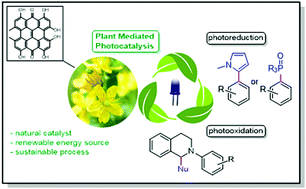(Flowers of St. John’s Wort serve as green catalyst)
2021/2/12 ドイツ連邦共和国・ドレスデン工科大学(TUDresden)
・ TU Dresden が、薬用植物であるセント・ジョーンズ・ワート(セイヨウオトギリソウ)のドライフラワーから抽出したヒペリシンが、光化学反応の活性触媒として利用できることを発見。
・ 火傷、座骨神経痛や抑うつ病等の病状に幅広く利用される同薬用植物は、医療的なポテンシャルが高く、「2015 年の薬草」に選ばれている(独・ヴュルツブルグ大学医学部医学史学科による年次賞)。
・ ヒペシリンは、同薬用植物の二次代謝産物。事前の化学処理なく利用できる光化学反応の活性物質として、従来触媒のグリーンでサステナブルな代替となる可能性が期待できる。
・ 天然物を利用してグラフェンのような 2D 構造の合成を目指した、ザクセン開発銀行が資金を提供する共同プロジェクトによる、バイオロジーと無機化学の異分野間の研究活動から生まれた成果(ドイツ特許出願済み)。
URL: https://tu-dresden.de/tu-dresden/newsportal/news/blueten-des-johanniskrautes-dienen-als-gruener-katalysator
<NEDO海外技術情報より>
(関連情報)
Green Chemistry 掲載論文(アブストラクトのみ:全文は有料)
Flowers of the plant genus Hypericum as versatile photoredox catalysts
URL: https://pubs.rsc.org/en/content/articlelanding/2021/GC/D0GC03281F#!divAbstract
Abstract
Photoredox catalysis is a powerful and modern strategy for the synthesis of complex organic molecules. So far, this field has relied on the use of a limited range of metal-based chromophores or artificial organic dyes. Here, we show that the ubiquitous plant genus Hypericum can be used as an efficient photoredox catalyst. The dried flowers efficiently catalyze two typical photoredox reactions, a photoreduction and a photooxidation reaction, with a versatile substrate scope. Constitution analysis of the worldwide available plant genus indicated that naphthodianthrones, namely the compounds of the hypericin family, are crucial for the photocatalytic activity of the dried plant material. In situ UV-vis spectroelectrochemical methods provide insights into the mechanism of the photoreduction reaction where the radical dianion of hypericin (Hyp˙2−) is the catalytically active species. Our strategy provides a sustainable, efficient and an easy to handle alternative for a variety of visible light induced photocatalytic reactions.




